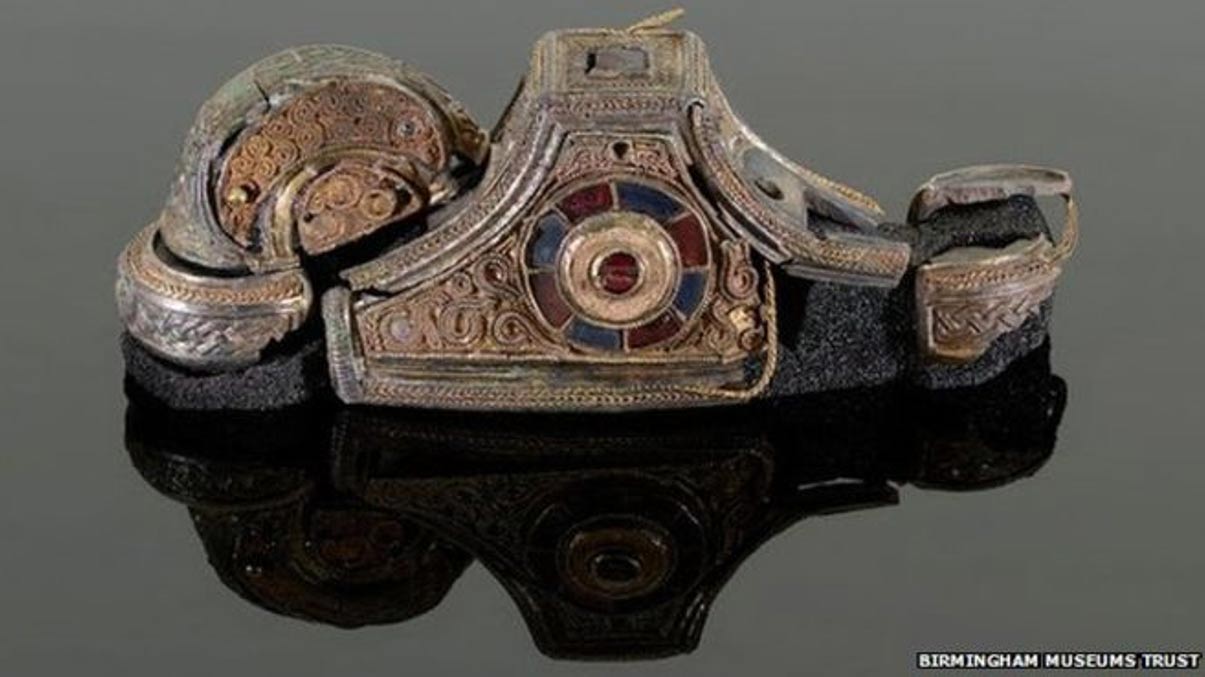Archaeologists piece together fragments from Anglo-Saxon gold hoard revealing stunning relics
Researchers in England have pieced together about 1,500 metal fragments, including gold and silver, to reconstruct a 7th century AD helmet and a sword pommel from the Staffordshire Hoard.
The artifacts, part of a cache of 4,000 items in the hoard, are on display in Birmingham's Museum and Art Gallery. The items comprise the largest Anglo-Saxon hoard of gold, silver, other metal and garnet ever found.
Conservators pieced together the sword pommel (pictured above), which is decorated with gold filigree, from 26 fragments. They reconstructed the dismantled helmet from about 1,500 fragile silver pieces. Some of the silver pieces were just 10 mm across, and conservators took a long time to reassemble the helmet along corrosion lines or deliberate cut lines.
The hoard was found in a field in Burntwood, Staffordshire, in 2009 and is worth an estimated £3.2 million (about $5 million). The hoard has been declared a national treasure and therefore belongs to the British Monarchy.

The helmet depicts armed men, birds animals and mythical beasts. Credit: Birmingham Museums Trust
Terry Herbert was using a metal detector in July 2009 to search farmland in the village of Hammerwich, in Staffordshire, England, that had recently been plowed. Suddenly his metal detector signalled that he had found a metal object. He would soon discover that he, literally and figuratively, had struck gold.
Herbert was stunned when he discovered the gold and silver pieces located by his metal detector. He began to collect the pieces he found, which had been scattered over a wide area because of the plowing. Over the next five days, Herbert filled 244 bags with gold objects that had been removed from the soil. At this point, he realized the site must be of great historical significance, and that there was likely more gold than he could ever recover on his own. Herbert contacted Duncan Slarke, the Finds Liaison Officer for the Staffordshire and West Midlands Portable Antiquities Scheme, and the owner of the land granted permission for an excavation of the land.
- Amazing Find with a Metal Detector - The Incredible Staffordshire Anglo-Saxon Gold Hoard
- Hidden hoard of more than 6,000 silver coins found in forest in Poland
- Explorers find Hidden Treasure in Cave – Coins and Jewelry Dating to Alexander the Great
A gold sword hilt-fitting with cloisonné garnet from the Staffordshire Anglo-Saxon gold hoard. Soil had not yet removed by conservators. (Photo by CC BY 2.0/Wikimedia Commons)
Researchers hope to reconstruct more objects from the hoard, but they need to raise money. Historic England has already given £400,000 ($615,500) toward efforts to conserve the hoard. The work includes cleaning gold, silver and garnet fragments and whole objects. The cities of Stoke-on-Trent and Birmingham control the hoard and intend to raise £120,000 ($184,650) more to reassemble bits and pieces of metal into whole artifacts.
"As technology and research methods develop we are able to discover more and more, and share the results, but more money needs to be raised to capitalise fully on this rich potential,” Duncan Wilson of Historic England told the BBC.
Some of the items were probably commissioned by England's early kings to reward warriors for their service.
Pieta Greaves, a conservation coordinator on the project, said, researchers were seeing a mix of styles, including British, Irish, Anglo Saxon and Christian art in the hoard.

Some of the precious pieces from the treasure hoard (Photo by CC BY 2.0/Wikimedia Commons)
Ancient Origins reported in March 2015 that the Staffordshire hoard has provided insight into ancient Anglo-Saxon civilization, while also generating some questions. The find shows that those who created these pieces had utilized a technique through which lower-grade gold with a high silver content could have the appearance of pure gold. This was accomplished by placing gold containing up to 25 percent silver in an acid solution, allowing the silver to leach out and to be burnished off. This gave the surface an appearance of pure gold, while the metal beneath was of an inferior quality. This was a fairly sophisticated method of deception in ancient times, leaving outsiders to believe the pieces were pure gold. Researchers have concluded that the pieces were of the highest-quality that the Anglo-Saxons could have manufactured, and that the finds must be from the culture’s elite. Additionally, he notes that some pieces appear to have been intentionally removed from swords, belts, etc., and that they do not match the appearance of what would be considered loot.
Featured image: A conservator reconstructed the pommel of a sword of a person with high status. Credit: Birmingham Museums Trust
By Mark Miller



















